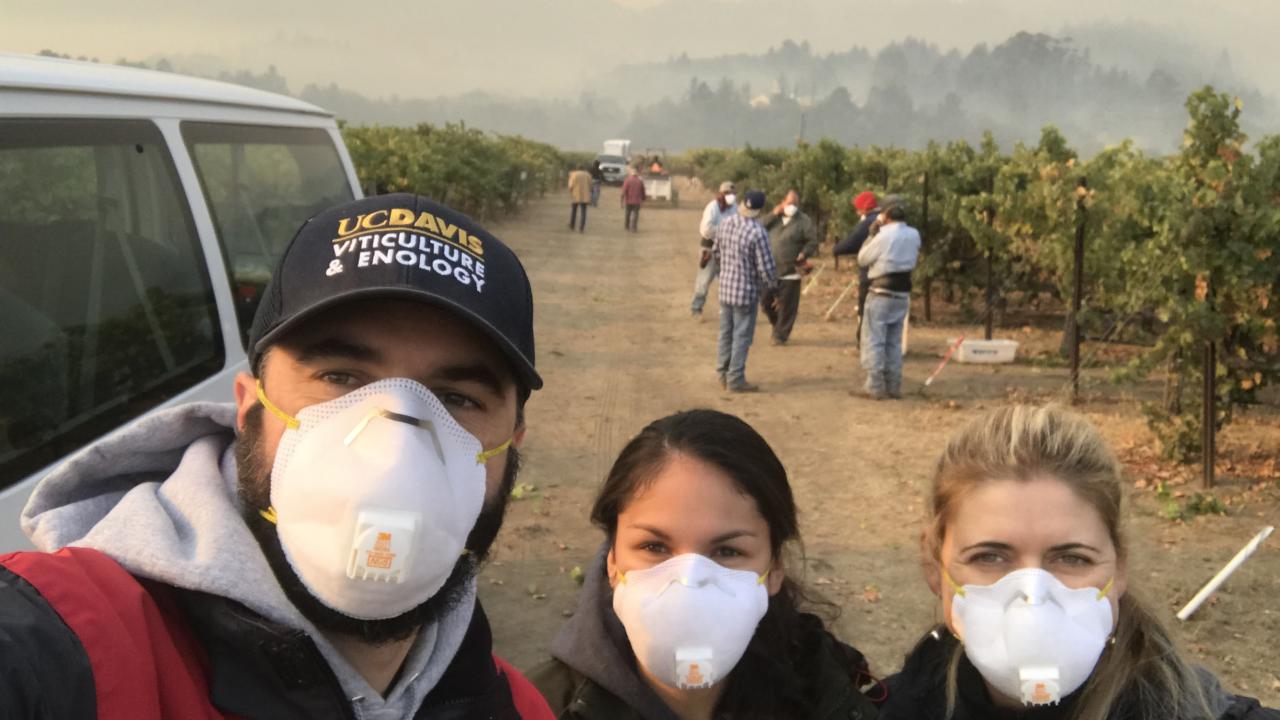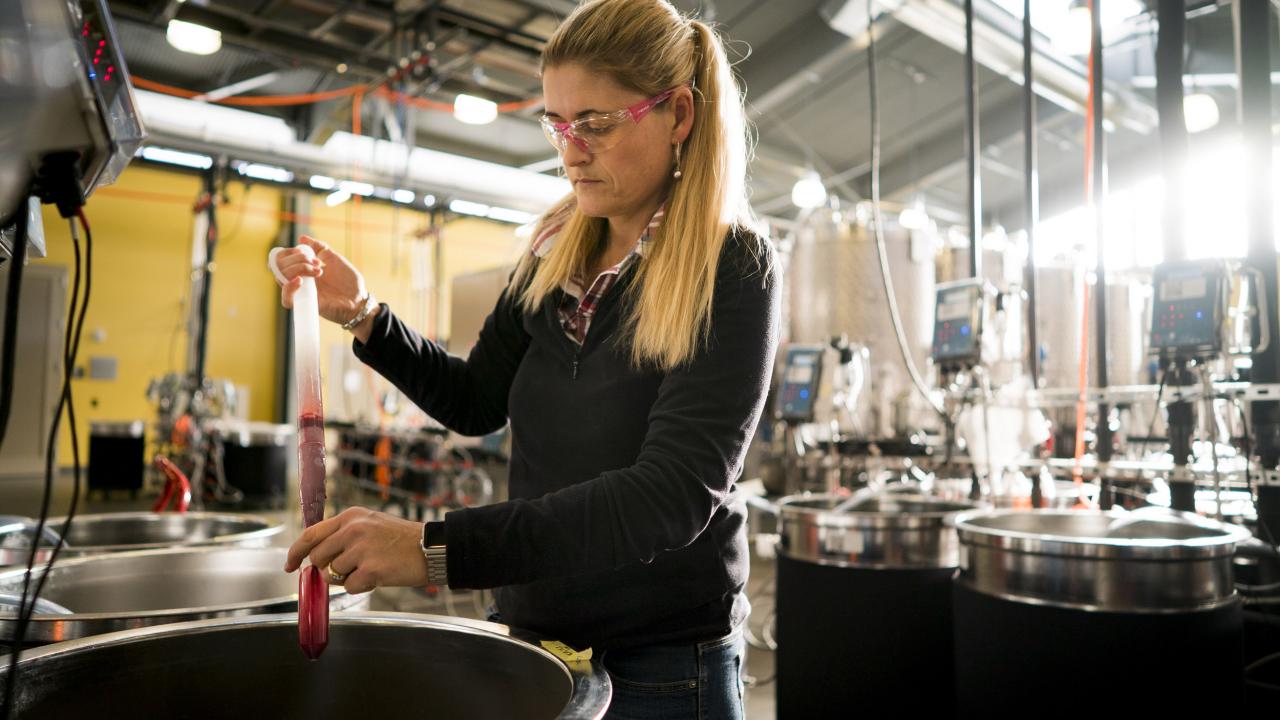
Exploring smoke taint on the fly
Wildfires spark UC Davis research, wine industry collaboration
The California wildfires of 2020 were especially hard on the state’s wine industry, damaging billions of dollars in property and grapes. Growers and vintners say it would have been much worse if not for timely science from the University of California, Davis. As destructive as they were, the 2020 wildfires have sparked renewed investment in the research and collaboration that keeps California’s wine industry resilient in a changing world.
“UC Davis researchers rose to the occasion, providing us practical, real-time information when we drastically needed it,” said Daniel Baron, winemaker and owner of Complant Wine, who formerly directed winemaking for Silver Oak and Twomey Cellars.
A look back on the 2020 fires can illuminate a path forward, Baron said, because they show how important it is for the wine industry to invest in smoke-taint research.
“Good science can save the industry a lot of financial hardship.”
A confluence of fire, smoke and COVID
Wildfires aren’t new to the wine country, but 2020 was different. The fires started earlier and affected many more acres of extremely valuable grapes. In August, the state was in lockdown due to COVID-19’s rapid spread and rising death toll when a series of lightning strikes sparked fires throughout the region just as harvest was getting underway. In late September, the Glass Fire raced through Napa and Sonoma, destroying 1,200 buildings and 30 wineries, and blanketing thousands of acres in smoke.
“It was a mess,” remembered David Block, UC Davis viticulture and enology professor and department chair. “At our campus vineyard in Oakville, we—like so many others—were harvesting grapes while fires were burning less than a mile away, and smoke was everywhere.”
When grapes are exposed to smoke, they can sometimes impart unwanted flavors into finished wine. It’s called smoke taint, and you know it when you taste it.
“Can you imagine licking an ashtray?” asked Anita Oberholster, a Cooperative Extension enology specialist at UC Davis. “When grapes are heavily impacted, it can taste like that.”

But smoke taint is complicated because you can’t predict which grapes may have suffered damage based on anything intuitive, such as sight, smell or even flavor of fresh grapes. Just because there’s smoke in the air doesn’t mean grapes are tainted.
“There are so many variables,” Oberholster explained. “Freshness of the smoke, number of times exposed, variety of grape, the list goes on. There’s so much we don’t know.”
When wood burns, it releases aroma compounds that can permeate grape skins and bond with sugars inside to form what are called glycosidically bound precursors. These molecules cannot be detected by smell or taste until they are released during fermentation due to the low pH of wines. Enzymes in saliva can release the bound glycosides, resulting in an ashy aftertaste.
Chemical analysis can help predict the likelihood of smoke taint, but the state’s commercial labs were backed up for several weeks in the fall of 2020 when grapes hung heavy on the vine.
“Growers were in a tough position because buyers were cancelling contracts unless you could prove your grapes hadn’t suffered damage, and demand for analysis far exceeded supply,” Block recalled.
Converting labs within days
To alleviate the testing backlog, the UC Davis College of Agricultural and Environmental Sciences and California Department of Food and Agriculture joined forces to help analyze wine and grape samples. Within several days, Block and his team gathered the right equipment, lined up the right collaborators and converted scientific labs into commercial facilities able to receive and test samples from vineyards and wineries throughout the state.
“Anita was the key to success because she donated an unpublished, validated assay (a molecular measurement tool) from her lab to identify seven smoke compounds used to assess smoke exposure,” Block said.
Meanwhile, Oberholster—the state’s only CE specialist in enology—was fielding literally hundreds of emails a day from anxious growers and vintners. With the campus on COVID-19 lockdown, she assembled a team of masked, essential workers to ferment and test grapes, publish fact sheets, hold webinars (600 people attended one of her Zoom events) and produce a step-by-step video on how to make wine in five-gallon buckets.
“Since many growers aren’t winemakers, we had to quickly show them how to ferment grapes in small batches so they could test for smoke exposure on their own,” Oberholster said.
All day, every day, Oberholster and her team fermented grapes in tanks, buckets and French presses to explore questions that had never been fully tested, such as how long do you have to ferment grapes to get accurate results? Does it matter if you wash your grapes before you ferment them? Does freshness of the smoke help predict risk?
“We were doing so many tests on the fly, just to give growers something to work with,” Oberholster said. “Now, before fire season returns, we need to do the basic science to back it up.”

Looking forward
Oberholster is one of the world’s leading experts on smoke taint, and she’s only been exploring the issue since 2017 when California wildfires seemingly became an annual event. As money for research becomes available, she has a long list of myths and mysteries to uncover.
“Number one, are we looking at the right molecules?” Oberholster asks. “We can’t fully assess smoke-related issues if we don’t completely understand the nature of the compounds at play.”
Smoke barriers are also on Oberholster’s radar. “Can we develop a spray that growers can apply to protect grapes from the compounds that burning wood emit?” she asked.
Oberholster would also love to help develop low-cost sensors to support growers’ ability to estimate smoke-taint risk. “That would expand lab capacity because you’d only have to test grapes that were in a high-risk zone,” she said.
As for myths, Oberholster wants to dispel the misconception that grapes and wine will automatically suffer in smokey conditions.
“Consumers have no reason to shy away from vintage 2020,” she said. “Winemakers don’t bottle a low-quality product. They know that if consumers taste wine that is off, they won’t reach for it again.”
Market analysist Jon Moramarco, UC Davis alum and owner of the firm bw166, estimates that the wildfires of 2020 cost the wine industry $3.7 billion in lost property, wine inventory, grapes and the wine those grapes would have produced. Moramarco, like winemaker Baron, says supporting smoke taint research makes good financial sense.
“Wildfires aren’t going away, and we will save ourselves a lot of financial hardship by investing in the world-class research underway at UC Davis,” Baron said.